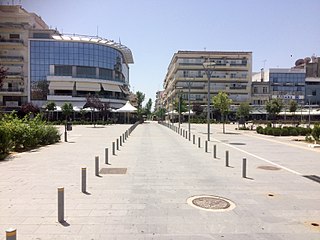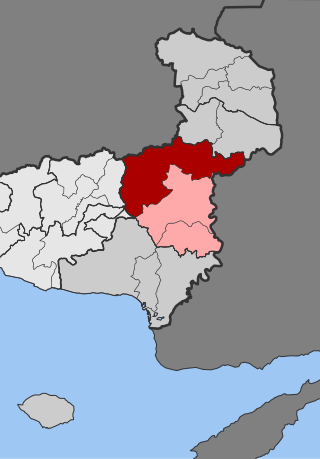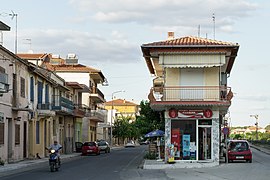
Evros is one of the regional units of Greece. It is part of the region of East Macedonia and Thrace. Its name is derived from the river Evros, which appears to have been a Thracian hydronym. Evros is the northernmost regional unit. It borders Turkey to the east, across the river Evros, and it borders Bulgaria to the north and the northwest.

Didymoteicho is a town located on the eastern edge of the Evros regional unit of Eastern Macedonia and Thrace, in northeastern Greece. It is the seat of the municipality of the same name. The town sits on a plain and located south east of Svilengrad, south of Edirne, Turkey and Orestiada, west of Uzunköprü, Turkey, about 20 km north of Soufli and about 90 km north of Alexandroupoli. The municipality of Didymóteicho has a land area of 565.4 km2 and a population of 16,060 inhabitants.
Kastanies is a town located in northern part of the regional unit of Evros, Greece, and is part of the municipal unit of Vyssa. It is situated at the border with Turkey.

Alexandroupolis or Alexandroupoli is a city in Greece and the capital of the Evros regional unit. It is the largest city in Greek Thrace and the region of Eastern Macedonia and Thrace, with a population of 71,751, and is an important port and commercial center for northeastern Greece.
Amorio is a village in the municipal unit of Orfeas, northeastern Evros, Greece. It is situated at 2 km from the right bank of the river Evros, that forms the border with Turkey here. Amorio is 6 km northeast of Lavara, 7 km southwest of Didymoteicho and 21 km west of Uzunköprü (Turkey). The Greek National Road 51/E85 and the railway from Alexandroupoli to Didymoteicho pass through the village.

Orestiada, is the northeasternmost, northernmost and newest city of Greece and the second largest town of the Evros regional unit of Thrace. Founded by Greek refugees from Edirne after the Treaty of Lausanne when the population exchange occurred between Turkey and Greece, in which the river Evros became the new border between the two countries. The population is around 20,000.

Orfeas, named after the mythical musician Orpheus, is a former municipality in the Evros regional unit, East Macedonia and Thrace, Greece. Since the 2011 local government reform it is part of the municipality Soufli, of which it is a municipal unit. Its land area is 643.266 km2 (248.366 sq mi). It is located in the north-central part of Evros, and borders both southeastern Bulgaria and northwestern Turkey. The seat of the municipality was in Lavara. Much of the land is mountainous and forested to the west, extending up to the Rhodope regional unit. It is linked with GR-51. The town of Lávara sits on a plain. It is located SE of Svilengrad, S of Edirne, Turkey and Orestiada, and 13 km N of Soufli and 78 km N of Alexandroupoli. The municipality's next largest towns are Agriani, Mega Dereio and Amorio.

Tycheró is a town and a former municipality in the Evros regional unit, East Macedonia and Thrace, Greece. Since the 2011 local government reform it is part of the municipality Soufli, of which it is a municipal unit. The municipal unit has an area of 220.411 km2. Tychero is situated near the river Evros, which forms the border with Turkey here.

The production of silk originated in Neolithic China within the Yangshao culture. Though it would later reach other places in the world, the art of silk production remained confined to China until the Silk Road opened at 114 BC. Even after trade opened, China maintained a virtual monopoly over silk production for another thousand years. The use of silk within China was not confined to clothing alone, and silk was used for a number of applications, such as writing. Within clothing, the color of silk worn also held social importance, and formed an important guide of social class during the Tang dynasty of China.

Thai silk is produced from the cocoons of Thai silkworms. Thailand's silkworm farmers cultivate both types of the domesticated silkworms that produce commercial silk: Samia ricini, commonly known as the eri silkworm, which produces matte eri silk, and the Bombyx mori, producer of the better known, glossy mulberry silk. The latter is by far the larger silk producer of the two.
Thourio is a village in the northern part of the Evros regional unit, in Greece. Thourio belongs to the municipality of Orestiada. It is located between Orestiada to the north and Didymoteicho to the south, about 4 km west of the river Evros, that forms the border with Turkey here. The nearest villages are Neo Cheimonio to the north and Sofiko to the south. Thourio lies 30 metres above sea level and is a lowland village with a fertile plain.
Dadia is a village and a community in the northwestern part of the Evros regional unit, Eastern Macedonia and Thrace, Greece. Dadia is in the municipality of Soufli. Its population in 2021 was 409 for the community, including the village Kotronia. It is located southwest of Soufli and north of Feres. The name originates from a resinous pine wood which in the past was used for lighting.
Ptelea is a village in the northern part of the Evros regional unit, Greece. It is part of the municipal unit of Trigono. It is located on the right bank of the river Evros, where it forms the border with Bulgaria. It is bypassed by the Greek National Road 51/E85. The town was formerly known as Karagatsoudi (Καραγατσούδι) and El-Karakas (Ελ-Καράκας), its Turkish name was Karaagaç. The nearest villages are Dikaia to its east, and Ormenio to its northwest.

Ormenio is the northernmost place in all of Greece. It is part of the municipal unit of Trigono in the Evros regional unit of Thrace. It is situated near the right bank of the river Evros, which forms the border with Bulgaria here. On the other side of the Evros, 6 km to the north, lies the Bulgarian town Svilengrad. Nearby villages in Greece are Ptelea to its southeast and Petrota to its southwest.
Dikaia is a village in the northern part of the Evros regional unit in Greece. Dikaia was the seat of the former municipality of Trigono, and is part of the municipality Orestiada since 2011. In 2021, its population was 557 for the community, which includes the villages Dilofos, Krios and Palli. It is located on the right bank of the river Evros, where it forms the border with Bulgaria. It is about 15 km southeast of Svilengrad, Bulgaria, and 25 km west of Edirne, Turkey.
Marasia is a village in the northern part of the Evros regional unit in Greece. Marasia is part of the municipal unit of Trigono. It is situated between the rivers Evros and Ardas, close to their confluence. The Evros forms the border with Turkey here, and the Turkish city Edirne is 7 km to its east. Marasia is bypassed by the Greek National Road 51/E85.

Greek National Road 51 is a predominantly single carriageway road in the Evros regional unit of Greece. The road is a branch of the EO2 from Alexandroupolis and runs almost parallel to the Evros river from Ardani in the south to Kastanies in the north, before meeting the D.100 road at the Greece–Turkey border towards Edirne. The EO51 is about 128 km long, and forms part of the European route E85.
Neo Cheimonio is a village in the municipality of Orestiada in the northern part of the Evros regional unit in Greece. It is 6 km south of the centre of Orestiada. Neo Cheimonio is situated on the Greek National Road 51, and has a station on the Ormenio - Didymoteicho railway. It is about 5 km west of the river Evros, that forms the border with Turkey here. The nearest village is Thourio to the south. It was annexed by Greece in 1920, prior it was ruled by the Ottomans.

Tussar silk is produced from larvae of several species of silkworms belonging to the moth genus Antheraea, including A. assamensis, A. paphia, A. pernyi, A. roylei, and A. yamamai. These silkworms live in the wild forests in trees belonging to Terminalia species and Shorea robusta, as well as other food plants such as jamun and oak found in South Asia, eating the leaves of the trees on which they live. Tussar silk is valued for its rich texture and natural, deep-gold colour, and varieties are produced in many countries, including China, India, Japan, and Sri Lanka.
Peplos is a town and a community of Feres municipal unit, Evros regional unit, East Macedonia and Thrace, Greece. Since the 2011 local government reform it is a part of the municipality Alexandroupoli. The town's population is around 1,000 people.





















